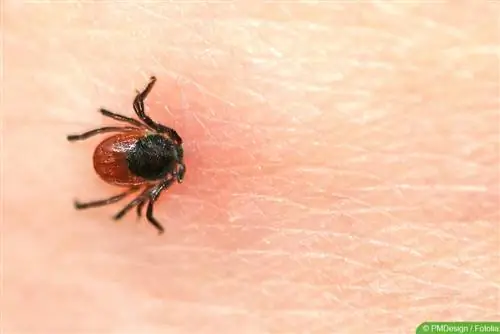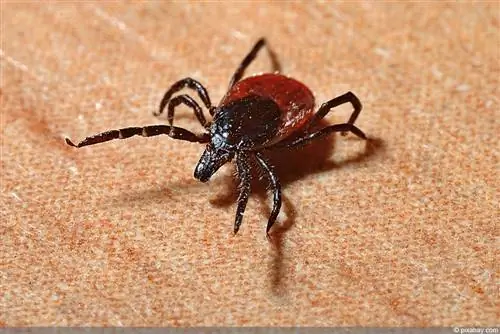- Author admin [email protected].
- Public 2023-12-17 03:39.
- Last modified 2025-01-24 12:45.
Many people react allergically to tick bites. There are many symptoms that should alarm the affected person.
What happens if a tick bites?
The tick pierces the victim's skin with its mouthparts and then sucks out the blood with a proboscis. As soon as you have discovered a tick on your skin, you should remove it if possible, as long-term contact increases the likelihood of transmitting a disease. It is best to carefully remove the tick from the skin with tweezers. If the mouthpart gets stuck, there is no need to worry; it will usually fall off on its own over time.
Symptoms of Lyme disease
Lyme disease is caused by the bacterium Borrelia burgdorferi. In principle, this bacterium can affect any organ of the infected person, but the joints and neuronal system are most commonly affected. These bacteria are transmitted by shield ticks, more precisely by the tick known as the common woodblock tick. This is the most common species found in Central Europe.
Generally, the disease Lyme disease progresses in three stages. Caution is advised if you experience the following symptoms:
- initial reddish to blue-reddish circular skin area at the area around the tick bite - may not occur under certain circumstances
- Wandering redness: the red area enlarges and fades in the middle, creating a reddish ring; The discoloration can also disappear on its own (which does not mean a cure!)
- sometimes the so-called Lyme flu occurs (10-14 days after the tick bite): fever, fatigue, conjunctivitis, swollen lymph nodes, muscle and joint pain, cough, runny nose, intestinal problems

If the symptoms mentioned occur, you should consult a doctor. If this does not happen, the following symptoms will appear in the second stage, around four to sixteen weeks after the tick bite:
- still Lyme disease flu
- uncontrolled sweats
- painful inflammation of the nerves in the face
- Meningitis
- severe headache
- Joint inflammation
- Disturbance of vision and touch
- Paralysis
- Heart racing
- high blood pressure
Lyme disease is not transmittable. However, both animals and people can become ill, and pets can bring the ticks into the house. Therefore, caution is advised. Lyme disease is notifiable in Germany.
Symptoms of tick-borne encephalitis
TBE is also transmitted from the common wood block. It is a disease caused by the TBE virus. Not all infected people are affected by the following symptoms:
- flu-like symptoms: headache, body aches, fever, fatigue
- Reduction in symptoms after a short time, improvement in well-being
- a few days later: return of the symptoms to a more severe extent, higher fever, neck pain, inflammation of the meninges and encephalitis (meningoencephalitis), inflammation of the spinal cord, nausea, impaired consciousness, seizures, paralysis, sensitivity to light and sound
Usually TBE is not as aggressive as Lyme disease. It is not uncommon for it to heal on its own and even in severe cases it is treated completely until recovery. However, if TBE progresses, in an emergency it can lead to paralysis or coma. These symptoms can last for months. In one percent of cases, TBE is fatal.
There is no targeted drug treatment for tick-borne encephalitis. The pain is usually relieved with painkillers and the nervous system is healed again with rehabilitation measures. TBE is also subject to reporting.
Protection against TBE

The best method to protect yourself against TBE is vaccination. Unfortunately, there is currently only one vaccination against tick-borne encephalitis, but not against Lyme disease. This is somewhat disappointing since Lyme disease is about 500 times more common. In order to be able to protect yourself more or less from it, you should go out in the countryside in the summer covered as much as possible; high boots, long trousers and covered arms can prevent a tick bite.
What you need to know about tick bites in brief
- The tick bites its victims; But unlike other biting insects, you don't notice the tick bite or the tick sucking. Unlike mosquitoes, for example, there is no itchy swelling. There are also no allergic reactions such as those caused by bee or wasp stings. Ticks bore unnoticed into thin areas of skin (back of the knees, head, neck or arms). Because of its size and weight, people also don't feel it moving on the skin to get to a suitable spot.
- If you get bitten by a tick, you may not realize that you have been bitten until much later. Mostly when showering or combing your hair in the evening or next morning. The main reason for this is that the tick's saliva contains an anesthetic that numbs the bite wound. The animal itself will also attract attention. This anesthetic is very important, especially since the tick's proboscis is many times larger and longer than the proboscis of other stinging insects. In order to remain unnoticed for as long as possible, the tick needs this protection.
- A tick that has just bitten its host is small (about ¼ of a matchstick head), has a black head and a reddish-brown abdomen. This swells and becomes bright red as soon as the tick fills with blood. Despite its small size, a tick requires a lot of blood - it can absorb up to 200 times its own body weight in blood.
- The fact that the saliva numbs the bite site contributes significantly to the danger of the tick. The saliva also has the task of preventing blood clotting and disinfecting the bite site and preventing inflammation. This is not done for the benefit of the host; The longer the bite goes unnoticed, the longer the tick can live on the host. The fact that you don't feel any pain from the bite, you don't feel the tick on your body and you don't get any inflammation from the tick bite ensures the tick's survival.






